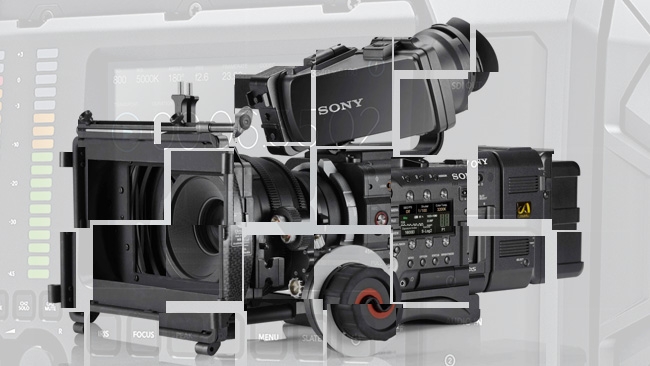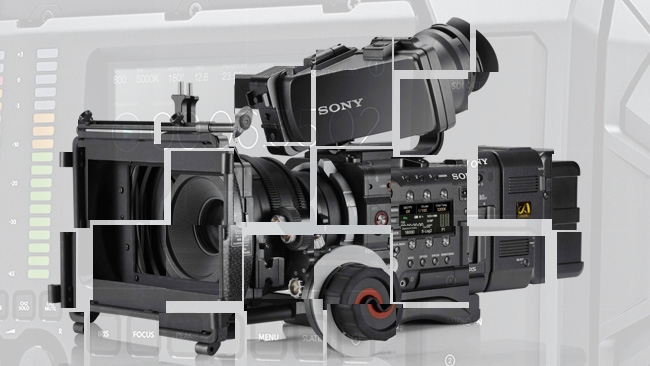
 The modular camera of the future?
The modular camera of the future?
Modular cameras, new entrants, and a shake up of the old guard; these are interesting times for the world’s camera manufacturers and potentially bountiful ones for the world’s camera consumers.
We have written before about the possibility of future cameras being modular. The manufacturers are clearly on the same wavelength with the new Varicam and the Blackmagic Ursa having the capability to change sensor configurations quickly and easily. Even Sony has recently announced the ability to upgrade its F5 to F55 specification, perhaps indicating the way it sees its competitors moving.
For a good while now there have been upstart companies attempting to build and sell their own cameras to compete with the big guys, but none of them have ever really managed to make a dent in the market. This has generally been the result of a combination of a lack of marketing clout, reliability issues, and quite often highly delayed release schedules. Bringing a new camera to market is difficult at the best of times, and it is knowledge of this very fact that has kept the large manufacturers safe, comfortable, and to a large degree rather humoured.
Times are gradually changing however. For the first time, with the AJA Cion and the Blackmagic URSA there might, finally, be two cameras to deal a serious blow to the big guys. Unlike many other smaller competitors who have attempted similar industry step changes here we have two companies who have marketing clout and established distribution chains.
Finding their feet
Blackmagic has come under fire for delayed releases of its previous cameras, the slow update cycle of firmware updates, and a lack of communication with existing users. The situation regarding "black blobs" in extreme highlights and some noise issues on the 4k Production Camera has not helped matters. However, while such issues cannot, and must not be ignored, bringing a new camera to market is no easy feat. Blackmagic has been having to gradually find its feet in this particular industry.
AJA has a good track record with its established product lines, but it is unproven when it comes to cameras. With luck it will have gotten things just right and the release will go without a hitch. What is certain for companies like Sony and Panasonic is that new rivals like Blackmagic and AJA are not going away any time soon, and if anything the market will become even more heated as even more independents successfully bring their products to market.
What does this ultimately mean for people who are in the market for a new camera and can these newcomers to the camera manufacturing industry ever truly take on the might of Sony and Panasonic? For one thing it will mean more choice, but Sony has always had huge advantages. The sheer reliability of its cameras is a huge selling point, and the sensors that Sony design and manufacture are among the very best in existence. In an industry where equipment is mission critical it is often best to go with what you know. Sony is a manufacturer from which you can purchase a camera and know that it will work, each and every time.
The big manufacturers have also established chains for after sales service too. Often at very short notice. I once bricked my PDW-510 XDCAM via a firmware update. I was an idiot and had decided to perform said update the day before a job. I won't be making that mistake again! A phone call to Sony later and I had made a quick trip down to their Basingstoke centre where they sorted out the problem for me there and then. They didn't even charge me for it. That's what I call service.
Red’s role
The ability to perform such after sales service, as well as having a network of approved repair centres across the world is an advantage that cannot be ignored. It is this very lack of such an after sales network that plagued Red in the early days. Got a problem with your camera in the UK? The chance of effecting a repair or temporary replacement at short notice was practically nil.
Red eventually overcame its initial reliability issues and after sales restrictions. There are still some grumbles I hear, as there would be for any company in reality, but the Red has now become a major force in the video camera world with the system being used on major feature films on a regular basis. How did this upstart manage to succeed where others have since failed? Some would say that Red have had faux success due to marketing hype and forums full of fanboys on the internet. It cannot be denied that those two things exist, and Red does have a habit of spouting announcements like a town crier. It should be noted though that top rated DoPs of big budget feature films and commercials do not use a camera based upon hype or the musings of some kids on a forum and businesses do not last approaching seven years without making money; therefore the success of Red is tangible, true, and undeniable.
Red was the first digital video camera manufacturer to give a practical solution to shooting in Raw with a dynamic range and in resolutions that until that point had been purely the domain of film. There had certainly been other digital cinema cameras before they came along, but none of them offered the combination of price, practicality, obtainability, and comparatively small size that the Red One offered, nor such a thought out Raw workflow. Here was a feature film capable camera that could be edited on a MacBook Pro. It wasn't so much the camera on its own that lead to the success of the Red One, but the whole package, from camera capability, size, and price, through to the workflow and support accessories. The immense marketing drive, word of mouth, and Apple style fandom on forums certainly helped them gain attention. Even going so far as to employ one of the forum owners in a senior position. He is now at the very top of the tree.
Red came in for a lot of flak in the early days, from myself included. Some well known DPs were even accusing them of being scam artists, once famously almost getting into a fist fight with Red’s owner, Jim Jannard at NAB. In the end Red had the final laugh and the company is going from strength to strength, even if there are still those who are resistant to them.
Constantly learning
This tells us that tenacity and a belief in what you are doing can save the day. Blackmagic has been going through similar teething issues. Its first camera was promising, but ultimately didn't offer much more than existing DSLRs. This is more apparent now when many DSLRs and newer, mirrorless cameras are now outperforming it. What cannot be ignored is the fact that the Cinema Camera, the Pocket Cinema Camera, and the Production Camera have taught them a lot. This may not go down too well with existing users who often feel that they have been beta testers, but in some ways this is to be expected when you live life on the bleeding edge.
Owners of those cameras will not cease to have functioning gear as a result of the new devices, but in terms of a roadmap the new URSA is a step that Blackmagic simply had to take. Much in the same way that Steve Jobs had to reboot the Mac with OS X, alienating a lot of existing users in the process. The URSA is a platform that will serve Blackmagic for a few years. It gives them an opportunity to test new sensors and eventually offer a lot of options for users. Those who cannot immediately afford the best sensor will have an opportunity to upgrade later and allow their cameras cost to be spread over a longer period than is currently possible with other manufacturers.
Both AJA and Blackmagic are better placed than many of the smaller upstarts to offer a good after sales service. This will be crucial to attracting new buyers to the Cion and URSA respectively. Quality control too must be top notch. Neither company can afford to have a repeat of the "black blob" or fixed pattern noise that has plagued the Blackmagic Production Camera. Such issues simply must, without any exception, be sorted out and thoroughly tested in the field before the cameras are released to the wider public, even if this means a delayed release. There is simply too much at stake, and despite the difference in price such issues could sway the outcome of the competition purely on the basis of trust and reliability.
An eye on the competition
Do the larger more established manufacturers care about all of this? Outwardly possibly not, but internally you can bet that they will be keeping a very close eye on things. After all it was the release of the Red One that pushed Sony into taking the digital cinema market more seriously. Whilst Sony have gradually given more options to buyers at ever decreasing prices they still have to protect their higher end lines. This is achieved by either restricting the form factor of the camera, restricting the codec ability, or both. When a rival company comes along and offers a much lower cost camera with better ergonomics and more choice of recording codec then the boat becomes somewhat upset!
Panasonic has never truly taken the large sensor market seriously and has instead focussed on third-inch camcorders at the low end, with the exception of the AF101. Effectively Sony is fighting battles from a number of fronts because they don't want to lose the smaller chip market either. The newly released Varicam has an uphill struggle ahead of it. It is true that the modular nature of the camera should be welcomed with open arms, but is it too little, too late? A 4K high framerate camera is nothing new. Red One has had this capability from, well, day one. The Red Epic took things even further. The truth is that the Varicam’s original USP, its variable framerate, is now a feature on many cameras, even in the lower price brackets. In fact the Red Epic is capable of up to 300fps in certain sensor configurations in 2K using the RedCode codec, compared to the new Varicam maximum of 240fps at standard HD resolutions in the AVCintra codec.
In the past the established manufacturers have been able to rely on their reputation as a safe bet, but the gap between them and the upstarts is now clearly closing. As the small guys iron out various issues they become much more of a viable alternative, and with the lower price of their gear the risk is often worth the punt. There will still be those who will say that you get what you pay for, and that the sensor performance of the Sony cameras is still far and away ahead. I cannot argue with this, however the flaw in the argument is that there comes a point with picture quality when something is "good enough". By that I do not mean to suggest that things cannot be improved upon, nor do I mean that you cannot tell the difference, but remember the 5% rule. To obtain that final increase in quality you need to spend even more money than that which took you 95% of the way there in the first place.
It is this very consideration that will lead people to purchase the AJA Cion and Blackmagic URSA, and by pricing their cameras at a point that can usurp both Sony's FS100 and FS700 the two new entrants have been canny indeed. Let the battle commence, and may the consumer win out!
Tags: Technology


Comments